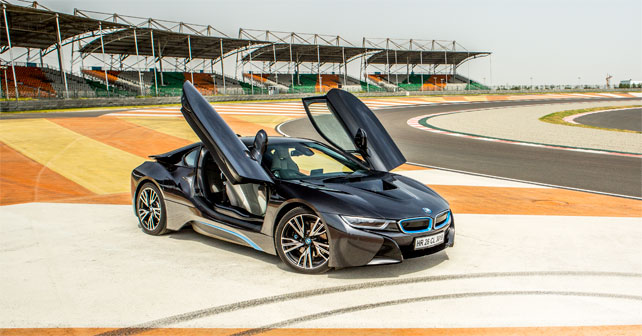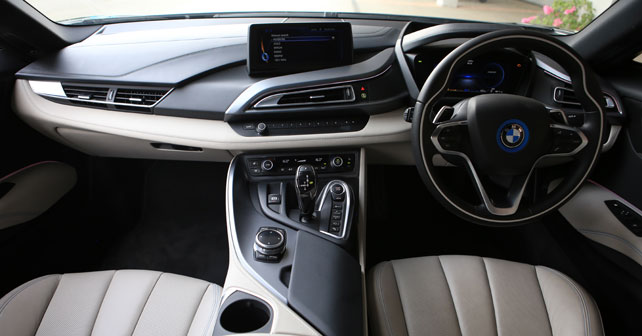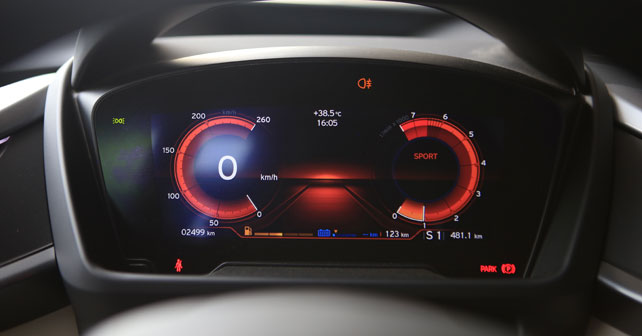We were incredibly impressed with the BMW i8 when we drove it in Italy last year. But what happens when you really put it to the test – when you unleash it at the BIC?
Now, let’s be clear, this is not a track car. It was never intended to be. It certainly looks as impressive as any other supercar out there – if not more so – but it was always intended to offer spirited performance on the road, rather than the track. And we know it does that very well indeed. So, why are we at the track then you ask?
Well, it’s very simple. This is the litmus test! We’ve always said that the racetrack provides truth in engineering better than any place else. And so we’re here to see what happens when you really push this machine to the limit. Do the incredibly svelte lines make promises that the driving experience can’t cash?
A little background to start with: the BMW Board approved the i program over half-a-dozen years ago now with the intention of truly getting to grips with electrification and efficiency – and doing it on their terms. And so the company took the bold step of developing the i3 and i8 under a completely new sub-brand. To say that this was a sink or swim moment for the company would be an understatement. Fortunately, both cars have been extremely well received – even if EV sales aren’t doing as well as people anticipated. A sharp drop in the price of oil has played a role of course, but so has the fact that battery technology simply hasn’t been able to keep pace with the overall advancements made by vehicles of this type.
The i8 is a pretty revolutionary machine all the same. It has a carbon fibre tub – as a supercar should. The incredible thing, though, is that the carbon fibre is developed by BMW itself. They’re manufacturing it at a green-field facility in the US using a brand new method that has allowed them to reduce the time and cost required to produce this incredibly light and strong material. In fact, we’ve already seen the use of carbon fibre increase in the rest of their range – such as the new M3/M4, as well as the less performance oriented next-generation 7 Series. In the new 7, for instance, it makes the car far lighter than before – which has the twin benefit of increasing performance and improving efficiency.
But, back to the i8 for the moment. It has an electric motor up front that produces the equivalent of 131 horsepower at the front wheels, and a 1.5-litre, turbocharged direct-injection, three cylinder petrol engine just behind the driver that produces 231 horses at the rear wheels. The lithium ion battery pack resides in the central tunnel, and the battery is charged while on the move by regenerative braking as well as an electric motor that feeds of the petrol engine. Of course, it does also need to be plugged in when stationary – for which it requires just a regular power outlet.
So, what does all this mean when out on the track? It starts out with an eerily silent exit from the pit lane. This is the first time that I’ve driven out of the pits at the BIC on electric power alone, and it’s quite a surreal experience if I’m honest. But, by the time we reach the first corner, I’ve flicked the gear lever to the left to engage Sport mode. The digital gauges glow an angry orange to immediately signal the change in character. The engine roars to life – did someone say it’s a puny three-cylinder motor? I would have guessed it was a V8 if I hadn’t just read the press release that BMW issued stating that this power unit just became the most recent recipient of the prestigious ‘International Engine of the Year’ award. On a side note, I wonder how long before they’ll have to change the name to ‘International Power Unit of the Year’ award. Well, I suppose it doesn’t have quite the same ring to it.
As we hurtle towards turn four, we’re fast approaching the top speed of 250km/h. Wow, can this machine accelerate! The whine from up front and the roar from the back is both a bit quizzical and extremely pleasing at the same time – especially when it results in power delivery like this. 0 to 100km/h in 4.4 seconds is not something to be scoffed at.
Braking at the end of the long straight is a little tentative – as the brake pedal takes a little bit of getting used to. It does have regen braking after all. The turn-in is as pointy as any car I’ve ever driven. Because this car has been developed from the ground up, and because the battery pack has been placed as low as possible in the centre of the car, it’s incredibly sharp to respond to your inputs. It takes a little bit of getting used to in fact. Not only does it have an incredibly low polar moment of inertia, but it’s also a extremely light – at just 1,485kgs. Every single nut and bolt has been especially developed to be as light as possible. And, of course, being a BMW the weight distribution is virtually 50:50 (49:51 to be exact).
All of this means that it handles incredibly well. Yes, mid-corner it does understeer a little more than you expect – but it corners completely flat, with no roll or drama whatsoever. It really does feel like one of those electric-powered slot cars that don’t deviate from their intended path of travel for love or money. The tyre size is relatively modest for a sports car, and you can get the rear end to move around a little bit – which can be more than mildly entertaining. You do wish that there was more feel from the steering wheel though, which is electric of course. But, fortunately, the chassis makes up for this by being as stiff and communicative as possible.
The incredible thing though – and I’ve said this before – is the seamless blend of electric and petrol propulsion. It simply feels like you’re riding a wave of torque and instant response all the time. Well, until I got to my third lap that is. Now, I promised the good folks at BMW that I wouldn’t pound around the BIC needlessly in this machine, so I only intended to do a handful of laps. And while I did turn off the traction control to feel just what the chassis was doing, I had no intention whatsoever of performing any histrionics on track – that kind of thing is best left to cars with an M-badge on the deck lid. The trouble here was, by the time I got properly used to how the i8 behaved on the track the battery pack had run out of juice. Theoretically, the regenerative braking, and even the burning of fossil fuel for that matter, should have been recharging the batteries. The trouble is that, on the track, you’re always asking the drivetrain for 100%. There’s no let up whatsoever. So, as my foot was flat to the carbon fibre floor, presumably the electric motor and the petrol engine were working at their absolute maximum to deliver all 362 horses to the rear wheels. So, when I did run out of juice, I suddenly had 130 hoses that refused to gallop out of the corners. Moreover, it’s been a hot summer and the track was dusty. I know, I know, I’m making excuses – but what I’m trying to say is that this car is capable of a far better lap time than what we achieved on the day of this test.
What was incredible, though, was the time during my first lap. I felt like I was poking around the track getting used to the drivetrain, but when I actually looked at the lap time it wasn’t too far removed from the fastest time that you see here. The thing is that it handles so well, and the power delivery is so effortless that you end up going a lot faster than you would imagine. When you push to the absolute limit though, things start to unravel a little bit. But if you just turn it down a notch – or even half a notch – and take a moment to appreciate just what BMW has been able to achieve with this machine, it’ll leave you gobsmacked.
The only limiting factor here – like in every other EV I’m afraid – is that the development in battery technology hasn’t kept pace with all the other systems that have been developed for a car like this. As is, it has an all-electric range of 37 kilometres. And this is just the first generation of this machine. Imagine just how impressive it’ll be by the time BMW develops its successor.
It’s been a huge gamble by the Bavarian giant, but its one that’s already starting to pay off – if nothing else in terms of the trickle down effect of all this technology. In itself, the i8 is an incredible machine. The track proved that the promise it hinted at out on the road is there for the taking. Yes, it’s not going to rival any supercars on pace just yet – but it certainly does rival the best of them in terms of curb appeal. Armed with its gullwing doors, and its ability to whisper sweet nothings as it sneaks past you, it really does feel like something that’s just come off the set of a sci-fi film.
So, if you want a track car get an M3. Well, for this much money, you could probably get an M3 and an M4 just to be sure. The i8 is for those of you who not only have the means, but also the inclination to electrify the present as you race towards the future. By no means is this a normal car, and it’s not for a normal buyer. This is a slice of the future, and it looks pretty bright indeed…
TEST NOTES
This machine is capable of a far better lap time than the one we recorded in this test. Not only were track temperatures high – despite which the car performed flawlessly throughout – but the battery got discharged after just a handful of laps at the limit. So, while it’s an incredible driving experience that far exceeds our expectations (despite the fact that it was never intended to be a track car), the limiting factor for the Bavarian engineers is battery technology. On the whole, though, this is a technological tour de force unlike anything on the road today.
- BMW i8
Combustion Engine: 1,499CC / 3 cylinders / 12 valves / TwinPower Turbo / Direct Injection / Valvetronic fully variable valve control
Electric Motor: BMW eDrive technology: hybrid synchronous motor with power electronics, integrated charging module and generator mode for recuperation
Fuel: Petrol
Battery: 355V lithium-ion
Transmission: 6-speed automatic (combustion engine), 2-stage automatic (electric motor) / combustion engine powers the rear wheels, electric motor powers the front wheels
Power: Combustion Engine – 231BHP @ 5800RPM, Electric Motor – 131BHP
Torque: Combustion Engine – 320NM @ 3700RPM, Electric Motor – 250NM
Acceleration: 0-100km/h – 4.4 secs
Price: Rs. 2.29 crores (Ex-showroom, Delhi)
2015 BMW i8 Video Review, Test Drive

CURRENT TEST
BMW i8
Lap Time: 2:24.6 | Top Speed: 224
* Slightly different circuit layout W = We










































Write your Comment